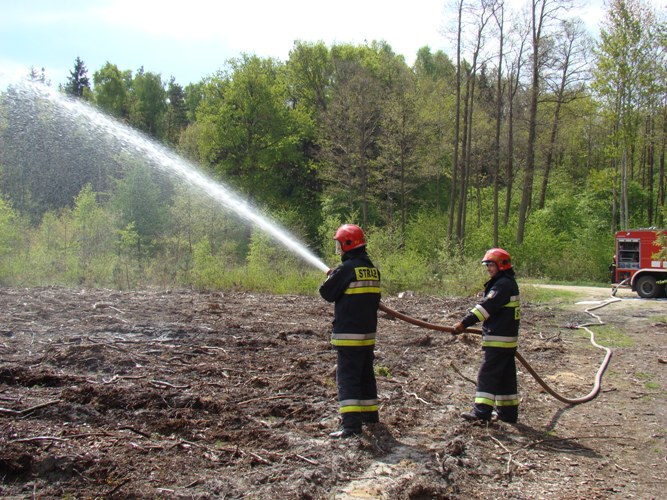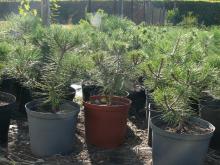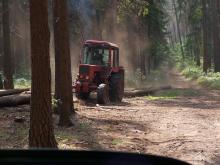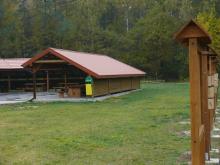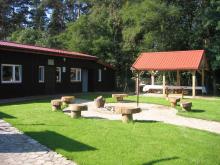 Asset Publisher
Asset Publisher
Polish forests
Poland is in the European lead, while concerning the area of all forests. They cover about 29,2 % of the country territory, and grow within the area of 9,1 million hectares. The overwhelming majority of the forests is state owned, of which almost 7,6 million hectares are managed by the State Forests National Forest Holding..
The number of Polish forest is still growing. The forestation rate of the country has increased from 21 % in 1945 to 29,2 % at the moment. Between 1995 and 2008, the forest area increased by 310 thousand ha. The basis for afforestation works is the "National Programme for Increasing the Forest Cover" (KPZL), assuming an increase of the forestation rate up to 30 % by 2020 and up to 33 % by 2050. Polish forests abound in flora, fauna and fungi. 65 % of the total number of animal species live there.
The forests grow in our country on poor soils, mainly because of the development of the agriculture in previous years. It influences the distribution of the types of the forest sites in Poland. Over 55 % of the forest areas is covered with coniferous forests. In other areas, there are forest sites, mainly the mixed ones. Their small part constitute alder and riparian forests – not more than 3 %.
In the years 1945 – 2011 the area of natural deciduous tree stands within the area of the State Forests National Forest Holding increased from 13 to 28,2 %.
Within the lowlands and uplands the most often occurring tee species is pine. It covers 64,3 % of the forest area of the State Forests National Forest Holding and 57,7 % of private and commune forests. In the mountains the predominant species is European spruce ( in the west) and European spruce with beech (in the east). Domination of pine is the result of carrying on sustainable forest management in the past. Once, the monocultures (crops or cultivations of one species) were the answer to the great demand of industry for wood. Such forests appeared to be quite fragile to climatic factors. They also were often the prey of pests' expansion.
In Polish forests, the share of other tree species, especially deciduous trees have been systematically increasing. The foresters have stepped aside from monocultures – that is why, they try to fit specific species of the forest stand to the natural stand, that would be proper for the given area. Thanks to that, in the years 1945 – 2011, the area of the deciduous tree stands within the lands of the State Forests National Forest Holding increased from 13 to 28,2 %. There occur more and more frequently the following tree species: oaks, ashes, maples, sycamore maples, elms, but also birches, beeches, alders, poplars, hornbeams, aspens, tilias and willows.
Our forests are the most often represented by the forest stands aged 40 to 80 years. The average age of the forest equals 60 years. More and more trees are of big size at the age over 80 years. Since the end of the Second World War, the forests' area has increased up to almost 1,85 million hectares.
Raport o stanie lasów w Polsce 2012
 Asset Publisher
Asset Publisher
Zauważyłeś pożar ALARMUJ !!!
Zauważyłeś pożar ALARMUJ !!!
Z dniem 20 marca 2023 roku rozpoczęła się bezpośrednia akcja przeciwpożarowa.
TELEFONY ALARMOWE
punkt alarmowo-dyspozycyjny
w godz. 8.00 - 15.15 tel. fax. 24 276 33 49 , kom. 784 434 758;
po godz. 15.15 tel. 24 276 33 49,
Telefony kontaktowe do leśnictw
Zawsze możesz zadzwonić pod 112, lub 998;
AKTUALNE ZAGROŻENIE POŻAROWE - ZOBACZ TUTAJ!
ZAKAZY WSTĘPU DO LASU - ZOBACZ TUTAJ
Lasy Nadleśnictwa Płock zostały zakwalifikowane do I kategorii zagrożenia pożarowego. Stanowią kompleksy leśne o dużym rozdrobnieniu, położone wśród lasów innej własności . Sąsiedztwo dużych aglomeracji miejskich sprzyja penetracji terenów leśnych przez lokalną ludność i liczne rzesze turystów zwłaszcza w okresie wiosennym i letnim.
Pożary są głównym i najniebezpieczniejszym zagrożeniem dla naszych lasów. Ogień szybko ogarnia ogromne połacie drzewostanów, tym samym pozbawiając zwierzęta miejsca do życia oraz doszczętnie niszcząc trwające od wieków działanie przyrody.
Najczęstsze przyczyny pożarów lasów, to:
- nieostrożność osób dorosłych przy posługiwaniu się ogniem otwartym, w tym papierosy, zapałki,
- podpalenia,
- wady urządzeń i instalacji.
Podczas pożaru lasu wydzielają się toksyczne dymy oddziałujące negatywnie na środowisko. Po pożarze las – naturalne płuca ziemi odradza się przez dziesiątki lat. W okresie największego zagrożenia pożarowego, tj. od 1 kwietnia do 31 października, często wystarczy iskra, aby spłonęło kilka, kilkanaście czy kilkadziesiąt hektarów lasu. Ludzie odpowiadają za powstanie ponad 90% pożarów lasów.
Pamiętaj! Z jednego drzewa można zrobić nawet milion zapałek, ale wystarczy tylko jedna zapałka, aby zniszczyć milion.
Jeśli zauważysz pożar w lesie to:
-
zawiadom o zaistniałej sytuacji straż pożarną (telefon 998 lub 112), nadleśnictwo,
-
oceń sytuację, jeżeli jest to zarzewie pożaru i zauważysz tlącą się pokrywę ściółkową, trawę, pojedyncze gałęzie na niewielkiej powierzchni (kilka m2), a także zboże lub ściernisko podejmij próbę jego ugaszenia, w tym celu wykorzystaj np.: gałęzie, koc, części ubioru, wodę (jeżeli jest dostępna), lub spróbuj przy pomocy łopaty odkryć wierzchnią warstwę ziemi by uniemożliwić rozprzestrzenianie się ognia,
-
jeżeli jest to pożar niemożliwy do ugaszenia przy pomocy dostępnych ci środków sprawdź czy jesteś w bezpiecznym miejscu, jeśli nie – uciekaj! W przypadku rozprzestrzeniania się pożaru ewakuuj się w kierunku prostopadłym do kierunku wiatru. Jeśli znajdziesz się w strefie zadymienia pochyl się nisko (przy ziemi jest mniej dymu) oraz osłoń usta i nos chustką lub częściami odzieży,
-
jeśli to możliwe udaj się na drogę dojazdową do lasu, oczekuj na jednostki straży pożarnej lub służbę leśną i wskaż im miejsce powstania pożaru.


 fot. Paweł Fabijański
fot. Paweł Fabijański
 fot. Paweł Fabijański
fot. Paweł Fabijański
 fot. Paweł Fabijański
fot. Paweł Fabijański

